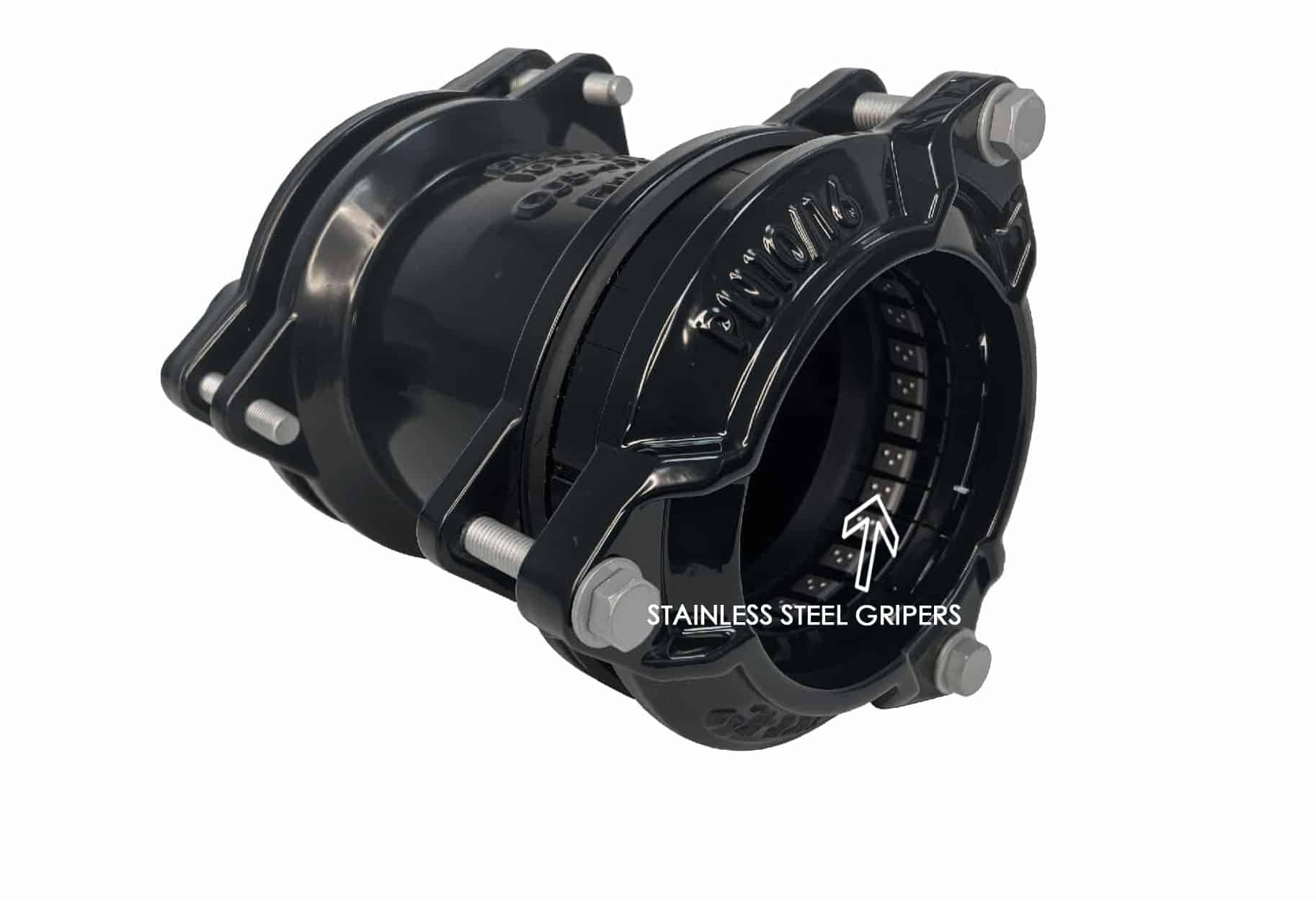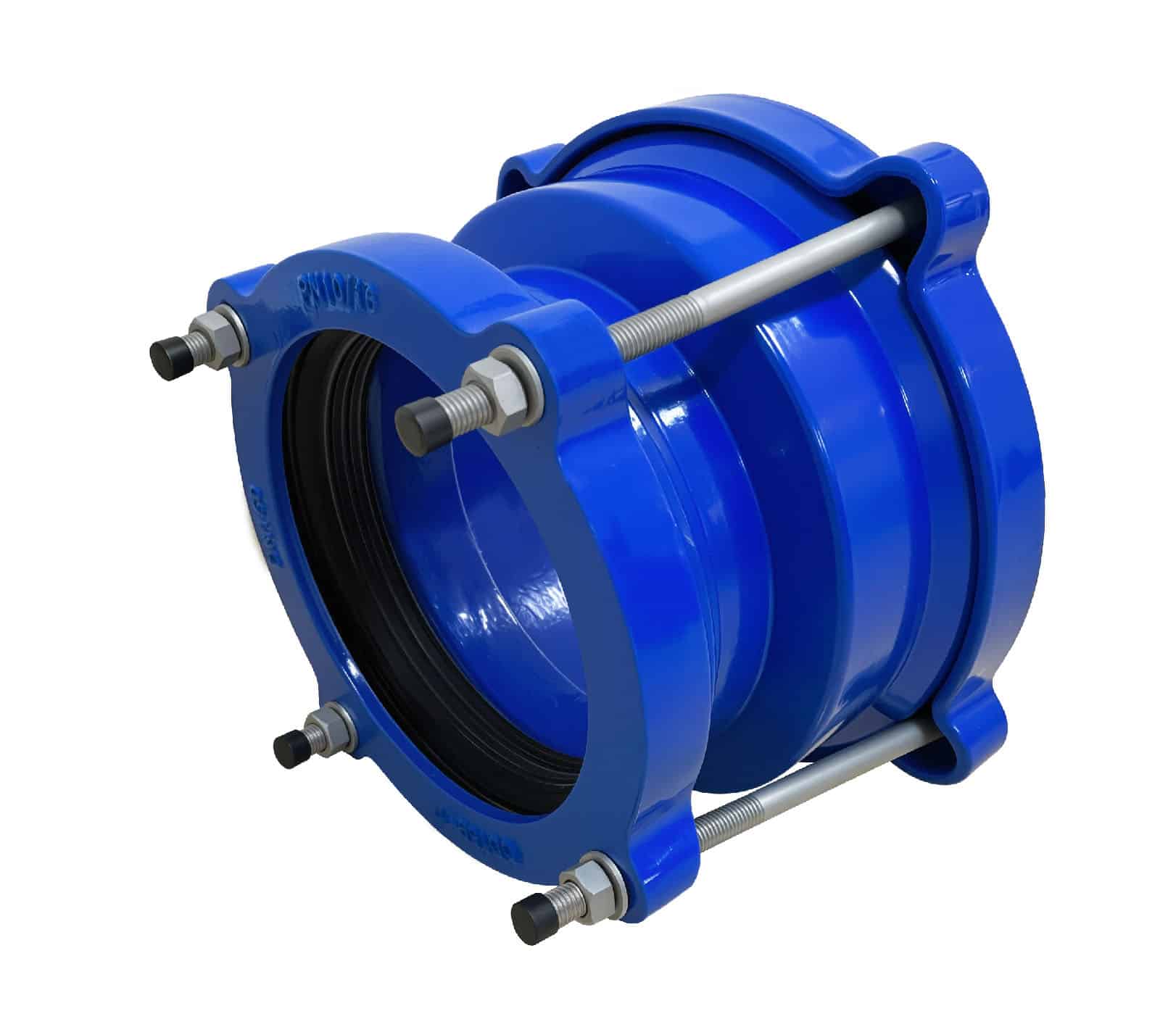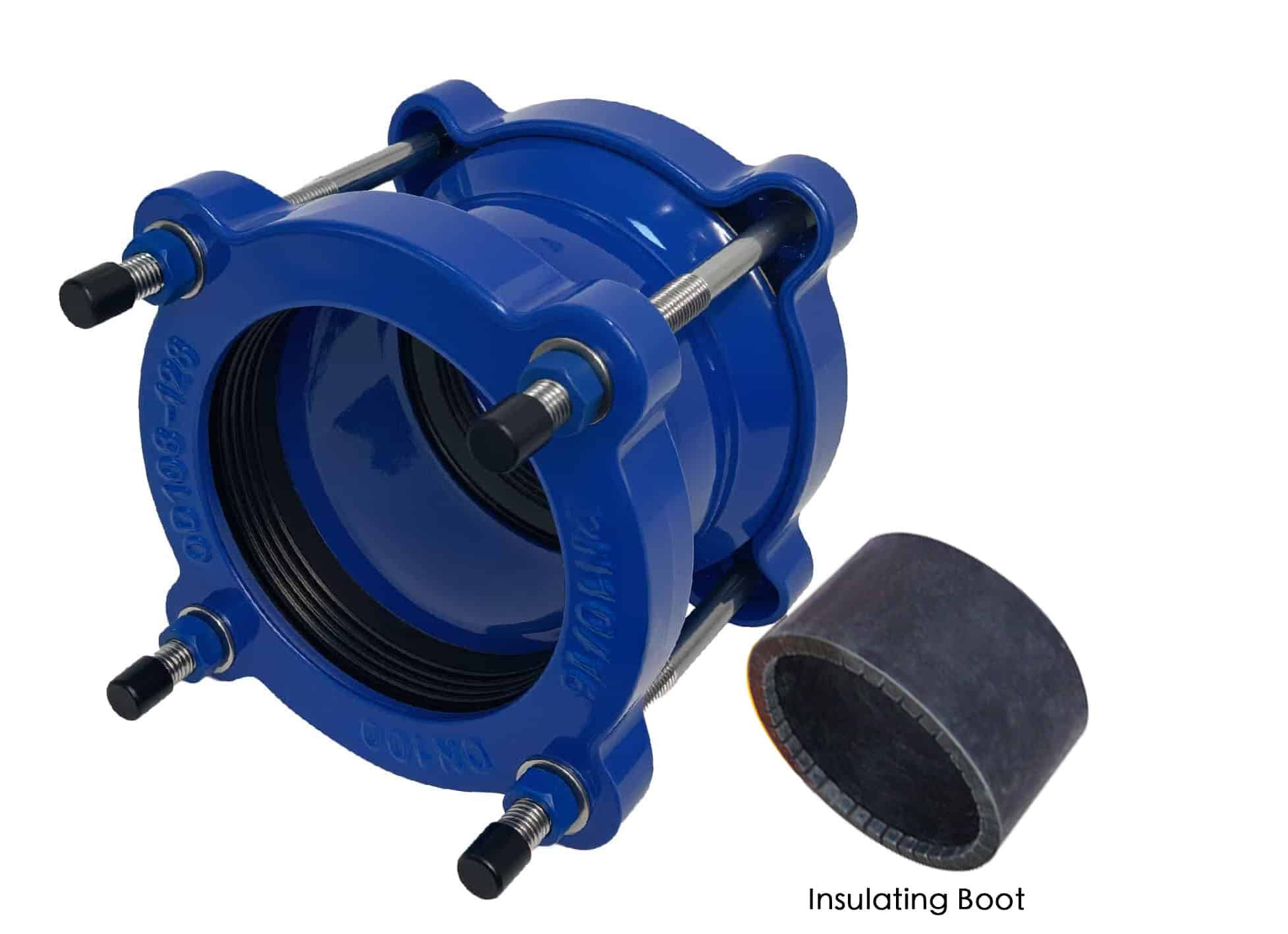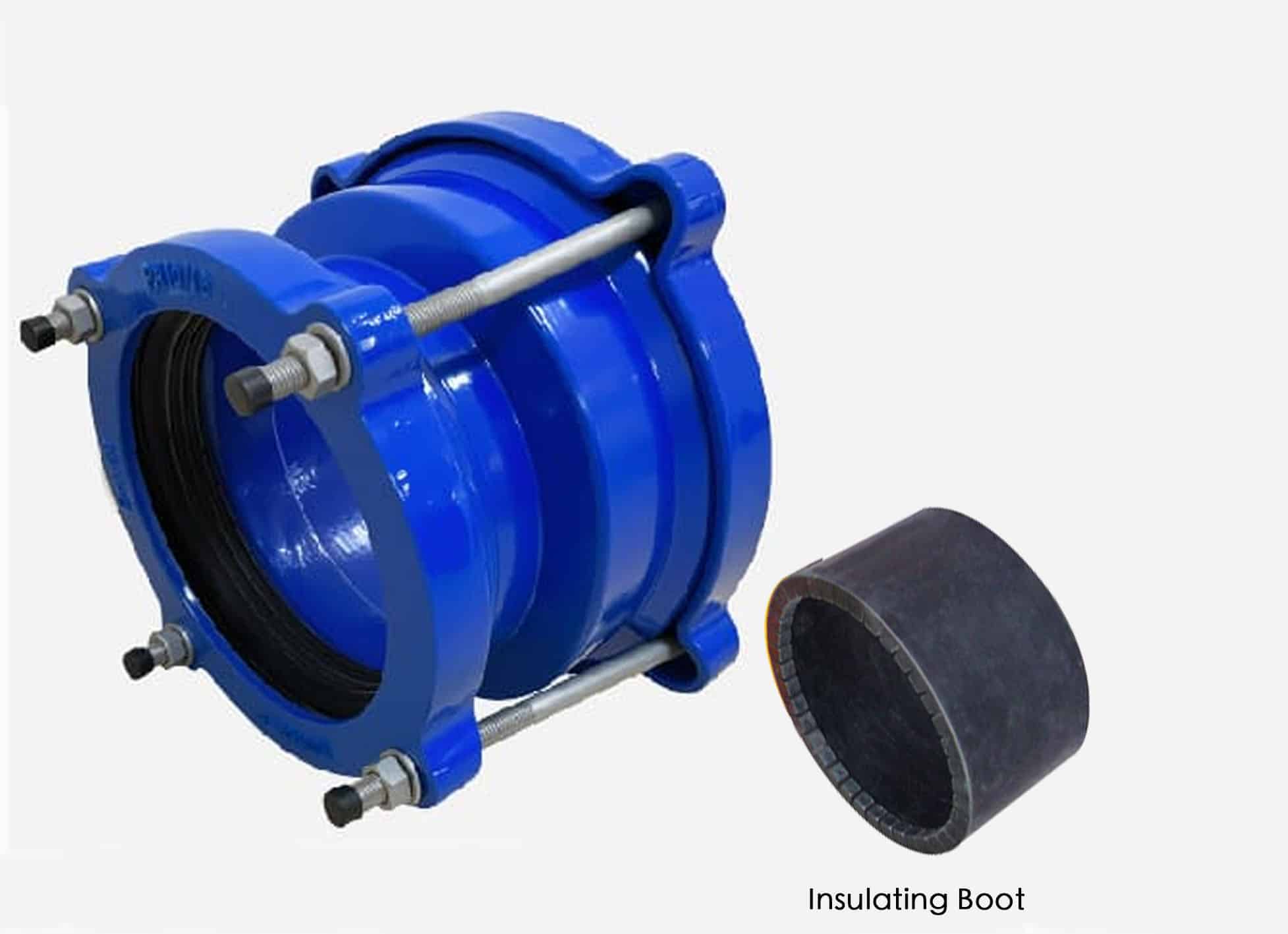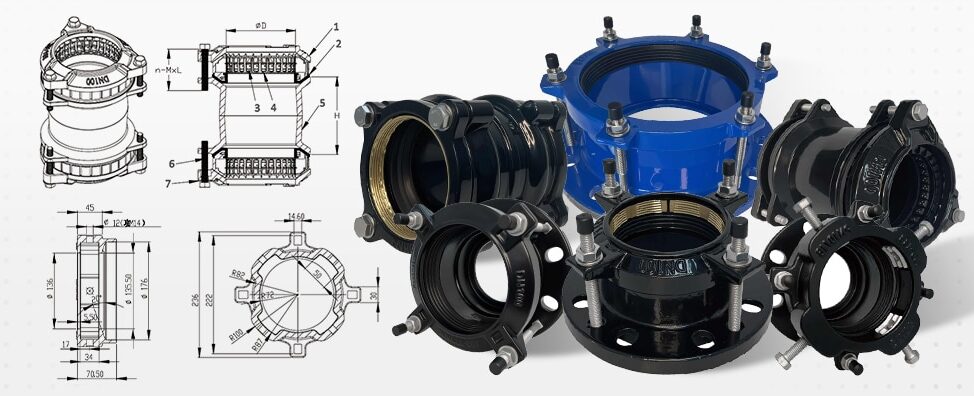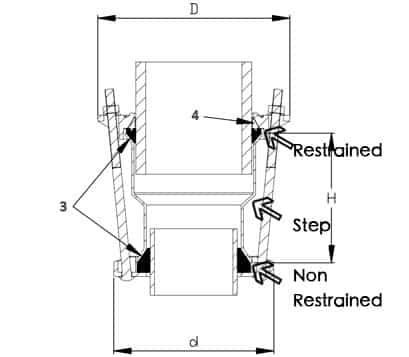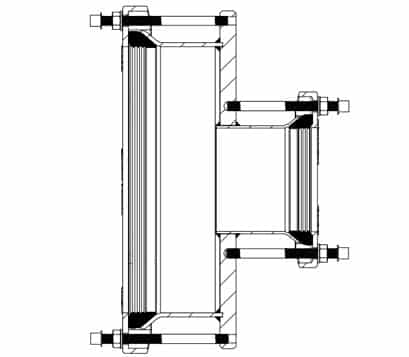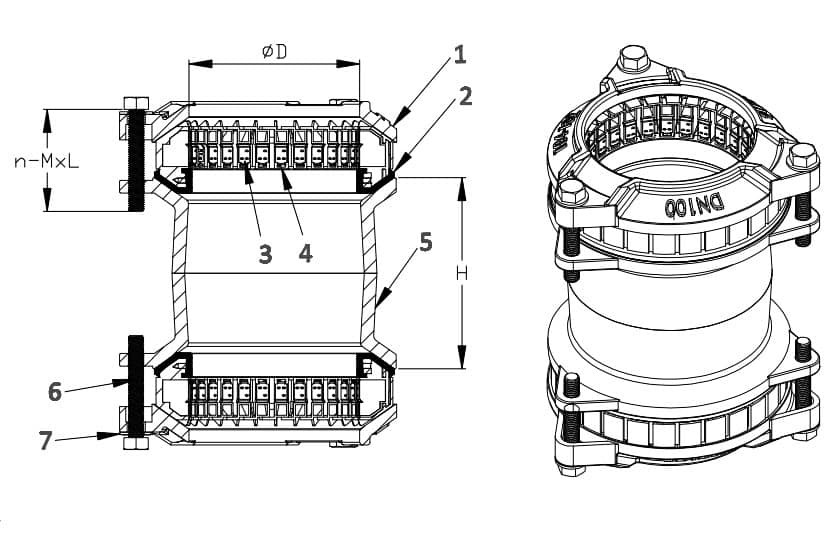Couplings to Connect Different Pipe Materials
1, How to connect ductile iron pipe to HDPE pipe?
When you’re working on real-world engineering projects, connecting ductile iron pipes to HDPE pipes presents some unique technical challenges, mainly because the two pipe materials are so different.
The Materials
Ductile Iron Pipe (DI):
Rigid, strong, doesn’t change shape, doesn’t stretch, can take a lot of pressure.
HDPE Pipe:
Flexible, stretches, shrinks, doesn’t like temperature changes or being pushed or pulled, not very stiff.
Because of these differences, the normal couplings that work great for metal-to-metal connections don’t work well for metal-to-HDPE connections.
Common Problems
HDPE pipe can stretch out under pressure, because of temperature changes, or because it’s getting longer.
The soft wall of HDPE pipe can squish or get out of round when you clamp it, and then it doesn’t seal.
If you don’t design the connection right, it will leak or fail over time.
The Solutions
Use Anti-Pull-Out Flexible Couplings (Locking-Type Couplings):
Use flexible couplings that have some kind of locking mechanism (like stainless steel grippers or wedge rings) on both ends or at least on the HDPE side to keep it from pulling out.
Put Stainless Steel Stiffeners Inside HDPE Pipes:
Hold the pipe wall up when you clamp it;
Keep it from squishing or getting out of round;
Keep the seal working over time;
Make the whole connection safer.
Use the Right Gaskets:
Use EPDM, NBR, or FKM gaskets based on what you’re pumping and the environment you’re working in to make sure you get a good seal.
How to Install Them
Make sure the pipe is the right size for the coupling.
Look at the end of the HDPE pipe and make sure it’s round.
Put the stainless steel stiffener in before you put the coupling on.
Use a torque wrench to tighten the bolts evenly in a couple of different passes.
After you put it together, test it with water to make sure it doesn’t leak.
Judberd’s Designs for DI to HDPE Connections
Design 1: Dual Locking-Type Coupling
Both ends have locking mechanisms.
Take the stainless steel grippers off the ductile iron pipe side when you put it together.
This design gives you a strong, safe connection that works in most applications, even if the ground is shaking or the temperature is changing.
Design 2: Single-Side Locking with Copper Gripper Ring
One side has a copper gripper ring for the HDPE pipe.
The other side connects directly to the ductile iron pipe without locking.
This design isn’t recommended for places where things are shaking or the pipe is getting longer; you have to be careful when you use it.
With Judberd’s professional coupling designs, you can safely and reliably make even the tough connections between ductile iron and HDPE pipes.
2, Best coupling for connecting PVC pipe to steel pipe?
In many water systems and industrial piping systems, you have to connect PVC pipe to steel pipe. But because these two materials are so different, you run into some technical challenges when you try to connect them.
The Materials
Steel Pipe: Rigid, heavy, strong, doesn’t change shape when you put pressure on it.
PVC Pipe: Light, flexible, stretches, shrinks, doesn’t like to be pushed or pulled, not very stiff.
Because these materials are so different, if you don’t design the connection right, you can squish the pipe, the seal can fail, or you can have problems over time.
The Problems
You can crack or squish the PVC pipe in one spot if you clamp it too hard when you put it together.
The stiffness difference between steel and PVC can cause the two pipes to move differently.
If you don’t account for it, vibration, settling, or temperature changes can make the seal fail.
PVC pipe doesn’t hold up well when you try to pull it out, and it can fail if you try to pull it apart.
The Solutions
Use a Step-Type Central Sleeve with Flexible Design (like this):
The coupling has a step in the middle that lets you put different size pipes in and seals them up on both sides.
Control the Clamping Force on the PVC Side:
Use wide gaskets to spread the clamping pressure out evenly. Make sure you don’t tighten it too much and squish the pipe because PVC is weak.
Use the Right Gaskets:
Use EPDM, NBR, or other gaskets based on what you’re pumping to make sure the seal lasts a long time (like potable water, wastewater, or chemicals).
How to Put It Together
Make sure the outside of the PVC pipe and the steel pipe are the right size for the step coupling you’re using.
Look at the end of the PVC pipe and make sure it’s smooth, round, and doesn’t have any cracks in it.
Use a torque wrench to tighten the bolts evenly in a couple of different passes.
Make sure you don’t tighten it too much on the PVC side and squish the pipe.
After you put it together, test it with water to make sure it doesn’t leak.
Judberd’s Designs for PVC to Steel Connections
Standard Flexible Step Coupling Design:
The middle of the coupling steps down so you can put different size pipes in and seal them up on both sides.
Custom Wide-Tolerance Design:
If you’re out in the field and the pipe sizes aren’t exactly what they’re supposed to be, Judberd has custom wide-tolerance couplings that make it easier to put together and work better in the field.
With Judberd’s custom flexible step coupling design, you can safely and reliably connect PVC pipe to steel pipe, even in tough field conditions.
3. How to join stainless steel pipe to carbon steel pipe?
When connecting stainless steel pipe to carbon steel pipe, the large potential difference between the two metals can lead to galvanic corrosion if they come into direct contact in a moist or electrolyte-rich environment. This will cause accelerated corrosion on the carbon steel side. To avoid this electrochemical corrosion risk, you should avoid direct contact between the two pipes during installation.
To further enhance safety and convenience during installation, our flexible pipe coupling is specially designed with an insulating boot. This insulating boot is installed between the two pipes, providing complete physical isolation between the stainless steel pipe and carbon steel pipe. This means that even if there are deviations or errors during on-site installation, the conductive path between metals is still effectively blocked, preventing galvanic corrosion.
At the same time, the surface of the coupling housing is coated with anti-corrosion layers (such as FBE or epoxy coating), and insulated EPDM gaskets are used to avoid direct contact between the pipe and the coupling body, thus forming a complete insulation system design.
In summary, by using a flexible pipe coupling equipped with an insulating boot, even under complex construction conditions or long-term operation, there will be no direct contact between the pipes and the coupling body, nor between the pipes themselves, effectively ensuring the safety and durability of the connection between stainless steel pipe and carbon steel pipe, and preventing electrochemical corrosion problems.
Flexible Coupling (for similar outside diameter pipes) with insulating boot
Step Flexible Coupling (for dissimilar outside diameter pipes) with insulating boot
4. Can I connect GRP pipe to ductile iron pipe?
You can connect GRP pipe (Glass Reinforced Plastic pipe) to ductile iron pipe, but you need to pay attention to the differences in material properties to ensure a safe and reliable connection over the long term.
First, there is no galvanic corrosion risk between GRP pipe and ductile iron pipe because GRP is a non-metallic insulating material, non-conductive, and does not form galvanic corrosion with ductile iron.
When connecting the two pipes, you need to pay attention to the following:
Difference in stiffness
GRP pipe is lighter and more flexible, while ductile iron pipe is stiff. The difference in stiffness can easily cause stress concentration at the connection. It is recommended to use flexible pipe couplings to absorb small displacements and stress changes.
Tightening torque control
GRP pipe has lower strength, and excessive torque during tightening may cause cracking or local deformation at the pipe end. It is recommended to strictly control the tightening torque during installation to avoid over-tightening.
Stiffener
For thin-wall GRP pipes, it is recommended to install stainless steel stiffeners inside the pipe ends to enhance compression resistance, prevent deformation during tightening, and ensure long-term sealing stability.
Sealing structure
Choose flexible couplings with wide gasket design to increase sealing surface width, distribute stress, and improve sealing performance.
Difference in thermal expansion
GRP and ductile iron have different thermal expansion coefficients. Temperature changes may cause displacement at the connection. Flexible couplings can absorb axial and angular displacement caused by thermal expansion, ensuring connection stability.
On-site alignment
Ensure good alignment between GRP pipe and ductile iron pipe during connection to avoid eccentric connection that may cause excessive stress on one side, affecting sealing and long-term stability.
In summary, when connecting GRP pipe to ductile iron pipe, it is recommended to use flexible couplings with wide gaskets, controlled tightening torque, and reinforced stiffeners, to ensure flexible compensation, sealing performance, and long-term safety at the connection.
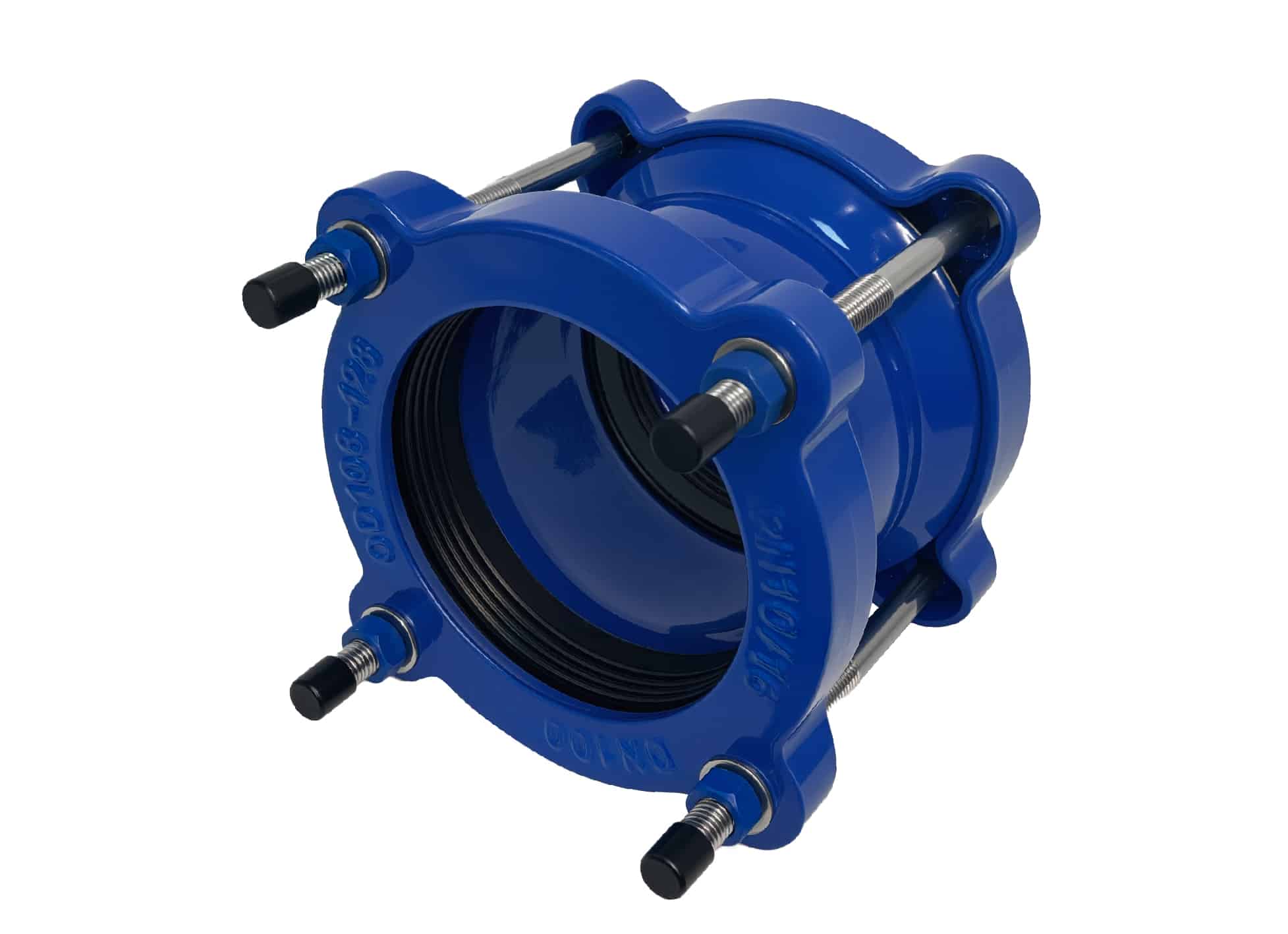
Flexible Pipe Couplings, Straight Type for Similar Pipe Outside Diameter
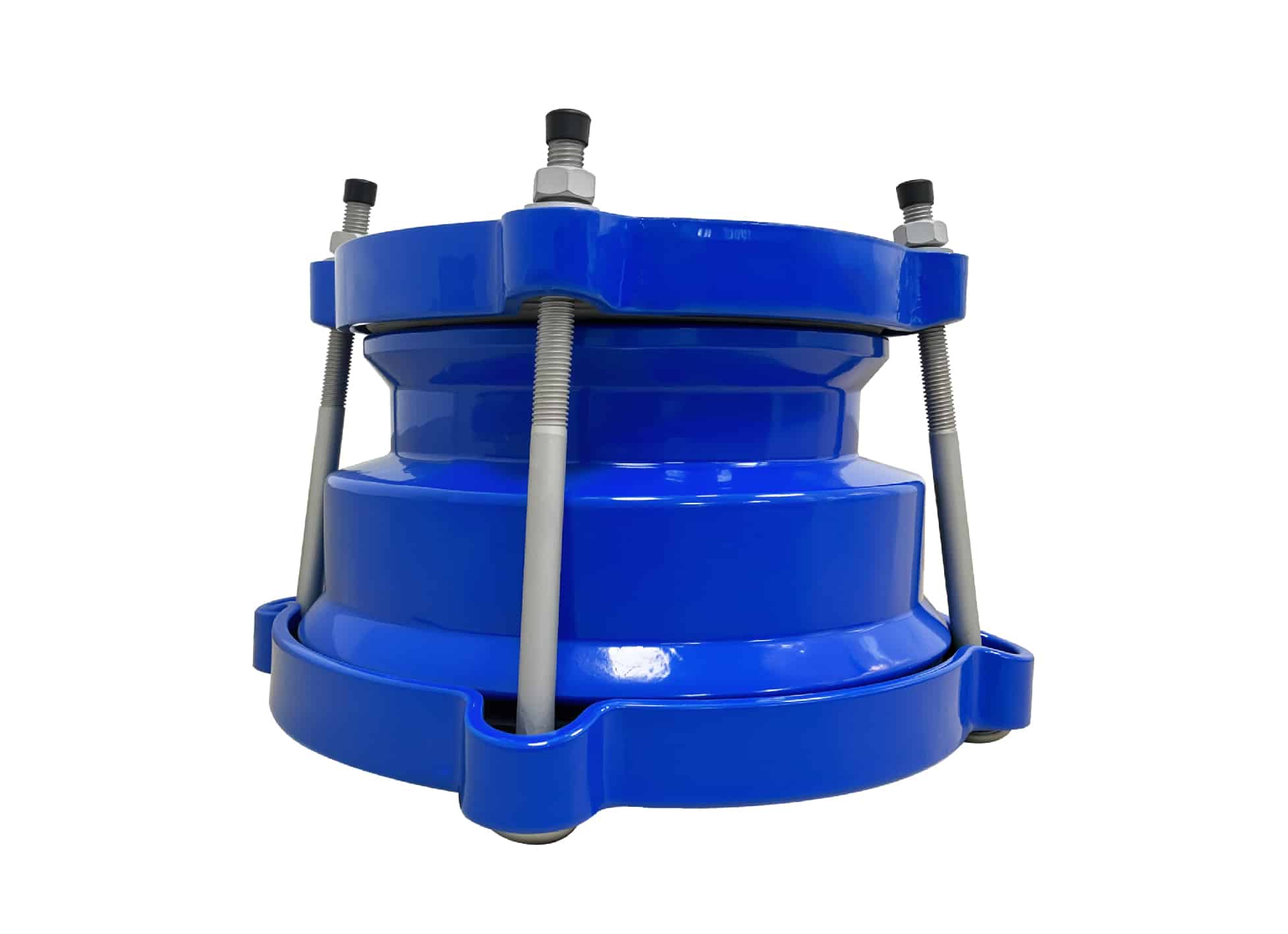
Flexible Pipe Couplings, Step Type for Dissimilar Pipe Outside Diameter
Common Causes of Leakage and Solutions for Connections Between Pipes of Different Materials
When connecting pipes made of different materials (such as metal to metal, metal to plastic, or plastic to plastic), the following are the most common causes of leakage:
1, Uneven Sealing Due to Different Stiffness, Different stiffness leads to uneven force distribution, resulting in uneven compression of the gasket and leakage.
Solution:Use flexible couplings with wide gasket design to increase sealing surface width and distribute stress;Ensure proper alignment during installation to avoid eccentric force.
2, Displacement Due to Different Thermal, Expansion, Temperature variations cause axial, lateral, or angular displacement, leading to gasket fatigue or pull-out.
Solution:Use flexible couplings capable of axial, lateral, and angular compensation;Reserve proper installation allowance to absorb thermal displacement.
3, Deformation of Thin-Walled Pipe Under Compression, Thin-walled pipes (such as HDPE, PVC, GRP) deform under tightening, damaging the sealing surface.
Solution:Use stainless steel stiffeners for thin-walled pipes to prevent end deformation;Control tightening torque to avoid over-tightening and damaging the pipe.
4, Joint Failure Due to Galvanic Corrosion, Large potential difference between dissimilar metals causes galvanic corrosion, damaging the sealing structure.
Solution:Use insulated couplings (insulated gaskets, insulating boots, FBE coating for coupling body);Prevent direct metal-to-metal contact and completely block the electrical path.
5, Sealing Failure Due to Incompatibility Between Gasket Material and Medium, Corrosion, aging, or swelling of the gasket due to the medium leads to sealing failure.
Solution:Select correct gasket material according to the medium, EPDM for neutral water, NBR for oil, FKM/Viton for high temperature and chemical media, PTFE for highly corrosive chemicals, Special rubbers for seawater, sewage, etc.
6, Gradual Failure Due to Long-Term Fatigue or Uneven Settlement, Long-term micro-movement, vibration, or ground settlement cause gasket fatigue aging and gradual failure.
Solution:Use couplings with flexible compensation design, capable of displacement compensation;Ensure stable foundation and high-quality installation for buried pipelines.
Precautions for Connecting Dissimilar Pipe Materials
1, Recommended Coupling Selection Table for Metal-to-Metal Pipe Connections(for Ductile Iron, Carbon Steel, Stainless Steel pipes)
| Pipe Combination | Common Issues | Recommended Coupling Solution | Notes |
|---|---|---|---|
| Ductile Iron + Carbon Steel | Galvanic corrosion (mild risk), stiffness difference | Flexible Coupling with anti-corrosion coating (FBE or Epoxy) | If long-term wet conditions exist, consider adding insulation gasket |
| Ductile Iron + Stainless Steel | High galvanic corrosion risk due to large potential difference | Flexible Coupling with full insulation design (insulating boot, isolating gaskets and FBE coating for whole coupling body) | Insulation is strongly recommended to prevent electrolytic corrosion |
| Carbon Steel + Stainless Steel | High galvanic corrosion risk | Flexible Coupling with full insulation design (insulating boot, isolating gaskets and FBE coating for whole coupling body) | Use insulation for long-term durability, especially in wet or outdoor environments |
| Ductile Iron + Ductile Iron | Minimal issues, similar materials | Standard Flexible Coupling | Normal anti-corrosion coating is sufficient |
| Carbon Steel + Carbon Steel | Uniform corrosion risk (if coating fails) | Flexible Coupling with external anti-corrosion coating | Use high-quality coatings (FBE, epoxy, hot-dip galvanizing) for durability |
| Stainless Steel + Stainless Steel | Minimal galvanic corrosion; crevice corrosion possible in some media | Standard Flexible Coupling | For marine or chloride-rich environments, select proper SS grade (316/316L recommended) |
Important Notes:
Galvanic corrosion occurs when dissimilar metals contact in presence of electrolyte; insulation methods are essential for long-term protection.
Flexible couplings should be selected with appropriate anti-corrosion coatings according to the environment (e.g. FBE for buried pipelines, epoxy for submerged or wet locations).
For Stainless Steel + Carbon Steel or Ductile Iron, always prioritize insulation design to prevent accelerated carbon steel or ductile iron corrosion.
Insulating components may include insulating gaskets, insulating boots and FBE coating for whole coupling body.
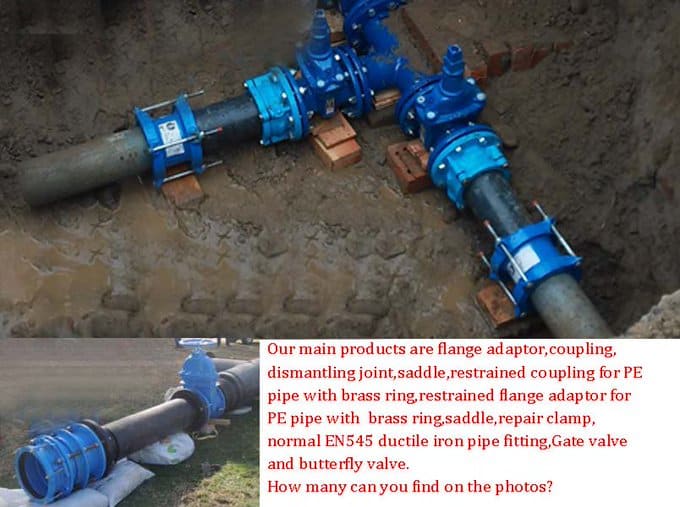
2, Recommended Coupling Selection Table for Plastic-to-Plastic Pipe Connections(for PVC and PE pipes)
| Pipe Combination | Common Issues | Recommended Coupling Solution | Notes |
|---|---|---|---|
| PE + PE | Large thermal expansion, pull-out risk | Flexible Coupling + Stainless Steel Stiffener | Strongly recommended for thin-wall SDR pipes |
| PVC + PVC | Brittle under stress, thermal expansion, sealing issues | Flexible Coupling with wide gasket design, controlled tightening torque | Avoid over-tightening to prevent cracking |
| PE + PVC | Stiffness difference, deformation risk | Flexible Coupling + Stiffener (for PE side) | Ensure proper alignment and even gasket compression |
| Different SDR or OD PE pipes | Diameter differences, sealing challenges | Customized reducer coupling + Stiffener | For large diameter difference, step restrained coupling or ultra grip coupling may be better |
| Different Plastic Materials (PE + PP, PVC + CPVC, etc.) | Material flexibility and thermal expansion differences | Flexible Coupling with customized gasket material | Ensure gasket compatibility with media and temperature |
General Notes:
No galvanic corrosion occurs in plastic-to-plastic connections.
Key concerns are mechanical strength, thermal expansion compatibility, and sealing reliability.
Wide gasket design reduces stress concentration on plastic pipe ends.
Stiffeners are critical for PE thin-wall pipes to prevent ovalization and ensure long-term sealing stability.
Torque control during installation is very important for PVC connections to avoid pipe cracking.
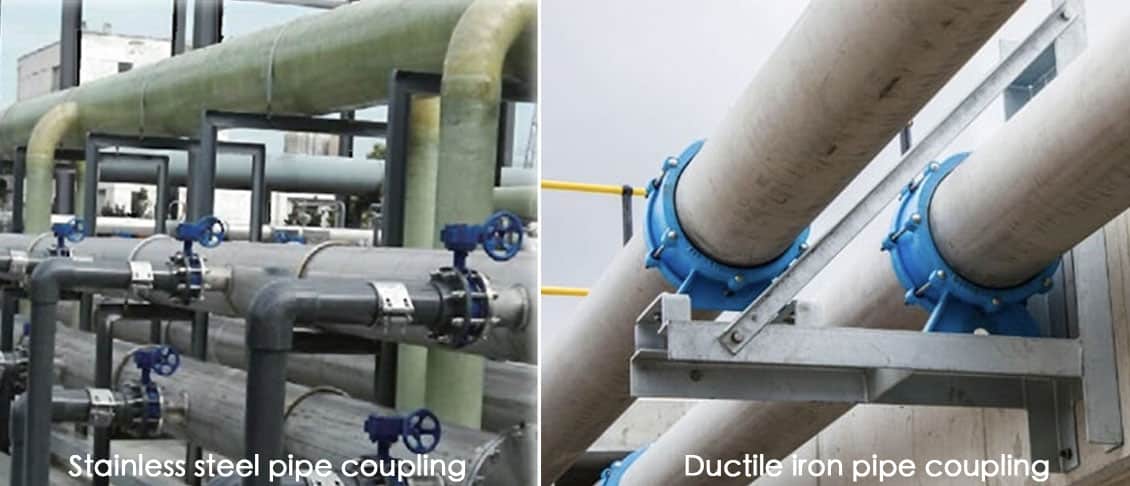
3, Recommended Coupling Selection Table for Metal-to-Plastic Pipe Connections(for PVC, PE, Ductile Iron, Carbon Steel, Stainless Steel pipes)
| Pipe Combination | Common Issues | Recommended Coupling Solution | Notes |
|---|---|---|---|
| Steel + PVC | Stiffness difference, thermal expansion, sealing issues | Flexible Coupling with wide gasket design | Control tightening torque, avoid over-compression |
| Steel + HDPE | Deformation, pull-out risk | Flexible Coupling + Stainless Steel Stiffener | The thinner the SDR, the more critical the stiffener |
| Stainless Steel + PVC | Expansion difference, sealing displacement | Flexible Coupling with fully encapsulated gasket design | Easy installation, good electrical insulation |
| Stainless Steel + HDPE | Thermal expansion, pull-out risk | Flexible Coupling + Stiffener or Flanged Adaptor with stiffener | For high pressure or underground use, flange adaptor is safer |
| Ductile Iron + PVC | Deformation, sealing failure | Flexible Coupling with wide gasket design | Good for accommodating settlement and misalignment |
| Ductile Iron + HDPE | Pull-out risk, insufficient wall support | Flexible Coupling + Stainless Steel Stiffener | Stiffener is especially important for large diameters |
Important Notes:
Flexible couplings are recommended with wide and fully encapsulated gaskets to protect plastic pipes from compression damage.
Stiffeners are highly recommended for HDPE thin wall pipes to prevent deformation and sealing failure.
Flange adaptors are better suited for high-pressure or critical pipeline sections, with easier maintenance.
Galvanic corrosion is not a concern for metal-to-plastic connections as plastic is non-conductive, but proper mechanical design is essential.
Couplings to Connect Different Pipe Sizes
Precautions and Solutions for Connecting Pipes of Different Diameters
When connecting pipes with different outer diameters or specifications, the common issues and corresponding solutions are as follows:
1, Sealing Difficulties Due to Outer Diameter Difference, Large difference in pipe outer diameters makes standard couplings incompatible, and the gasket cannot be effectively compressed for sealing.
So you need to Use reducer flexible couplings, specially designed for different pipe diameters;Customize gasket and inner housing dimensions to ensure reliable sealing pressure on both sides.
2, Poor Sealing Due to Eccentric Installation, Difficult alignment for different pipe diameters, leading to eccentric connection and uneven force on the sealing surface.
So you need Strengthen alignment positioning during on-site installation;Some high-end reducer couplings have guiding and positioning structures to ensure even gasket compression.
3, Risk of Local Deformation for Thin-Wall Pipes, During tightening, small-diameter thin-wall pipe ends may deform into oval shapes under concentrated local pressure, damaging the seal.
You need Use stainless steel stiffeners inside thin-wall pipe ends;Control tightening torque and apply uniform, gradual tightening.
4,Thermal Expansion Difference for Different Pipe Materials, Large differences in thermal expansion coefficients between different materials may cause axial or angular displacement under temperature changes, affecting sealing life.
So you need Use flexible couplings with compensation capability to absorb thermal displacement;Reserve reasonable installation allowance to avoid stress concentration under extreme conditions.
5,Structural Strength Change After Diameter Reduction, Sudden diameter change areas easily form stress concentration zones, posing fatigue risks under long-term pressure.
So you need Use smooth transition designs for reducer sections as much as possible;For high-pressure systems, flanged reducer adaptors are recommended to enhance structural strength and safety.

Reducer Flexible Couplings
Judberd Custom coupling solutions for special pipe connections
For the condition where one end connects to an HDPE pipe and the other end connects to a ductile iron pipe, we have designed a locking ring structure on the HDPE side to prevent the HDPE pipe from pulling out easily. The other end uses a flexible type without a locking device to connect to the ductile iron pipe. As shown in the diagram below.
For the situation where one end connects to a very large pipe and the other end connects to a much smaller pipe, we have specially designed a middle barrel structure to perfectly connect pipes with a large outer diameter difference. As shown in the diagram below.
For conditions where both ends connect to pipes made of different materials, with significant thermal expansion and ground settlement, we have designed an ultra grip coupling. It can connect pipes of different materials and outer diameters on both ends, and is equipped with plastic locking rings to grip the pipes and prevent leakage. As shown in the diagram below.
If you have any question or enquiry ,welcome you
Contact us: info@judberd.com
WhatsApp: 008615315522185

